I arrived at about 3:00 AM on Tuesday, Jan 24th in Mumbai’s Chhatrapati (double h) Shivaji International Airport. Baggage claim was pokey, but customs was a breeze, and I proceeded to the pre-paid taxi stand at the airport (if you’re unfamiliar with Mumbai, don’t haggle with cabbies upon arrival at the airport – you’re more likely to get a fair deal via the pre-paid stand).
My taxi to the Colaba area of town, where my guesthouse was, cost me 460 rupees. I tried to split the ride with other backpackers that had also just arrived at the airport, but nobody was headed my way. The prepaid taxi desk clerk gave me a receipt and a four-digit cab number to seek out (5332 in my case) and I walked out of the terminal and down a long line of cabs – some nice, new ones and some black-and-yellow rattletraps. 5332 was a rough looking minivan in the latter style. My driver had a hacking cough and a penchant for spitting out the window. It was cool and dusty outside.
At 4:00 AM, Mumbai (population around 21 million) is asleep. Nearly zero traffic meant only an hour of transit time to Colaba. A few stray cabs and autorickshaws competed for space with my taxi even though the roads were otherwise empty. Beep! The only other activity on the streets were laborers unloading fresh produce off lorries for morning markets.
Mumbai is what everyone says – an exercise in juxtaposition. Chewed up concrete/corrugated metal buildings butt up against new construction of shiny high-rises. Groups of people were sleeping on the street and sidewalks in groups of two, five, ten. I’m guessing that these folks aren’t homeless – they’re just poor – and they probably sleep in the same spot every night. Meanwhile, the wealthy of the city never seem roll their luxury car windows down. The division of wealth here is extreme.
My taxi driver spoke a sort of English, and we muddled through the search for my guest house, which didn’t have a well-lit sign. The driver seemed to expect me to know where it was. We pulled up and down streets in a three-or-so block radius asking early risers on the street where Bentley’s Hotel was. We narrowed it down and landed.
“No tips?” my driver gave me puppy dog eyes. “No, taxi is prepaid,” I proclaimed (correctly), and proceeded into the dark guesthouse with my backpack.
“24-Hour Reception” in this case meant that the clerk was asleep on the floor next to the front desk. I rang the bell at 5:00 AM and watched the young man on the floor struggle out of a deep sleep to help me get situated. He paged through the thick, heavy ledger book of reservations to find my name and walked me upstairs. My room was around 1600 rupees, or US $32/night for a double.
Note: when arriving in Mumbai on an early flight (many international flights come in at 3:00 AM, 4:30 AM), hotels may or may not offer forgiveness to the weary traveler and give them a super-early check-in for no additional cost. Mine, of course, did not, so I had to shell out a full day’s room rental just for a shower and five or so hours of sleep. But it was worth it – I needed to attempt to correct my cycle, which was now 11.5 hours removed from my usual American Central Standard Time.
The room was spartan but clean, with a private bathroom and two small hard beds. A TV that would go unused was tacked on the wall (could I give the TV back and get a cheaper rate?!?). Surveying the bathroom, I came to realize what I hadn’t included in my pack – toilet paper. A small, but potentially critical oversight in the land of eating with one’s right hand and one’s right hand only. I had a momentarily warm shower (then a longer period of cold) and went down for the night.
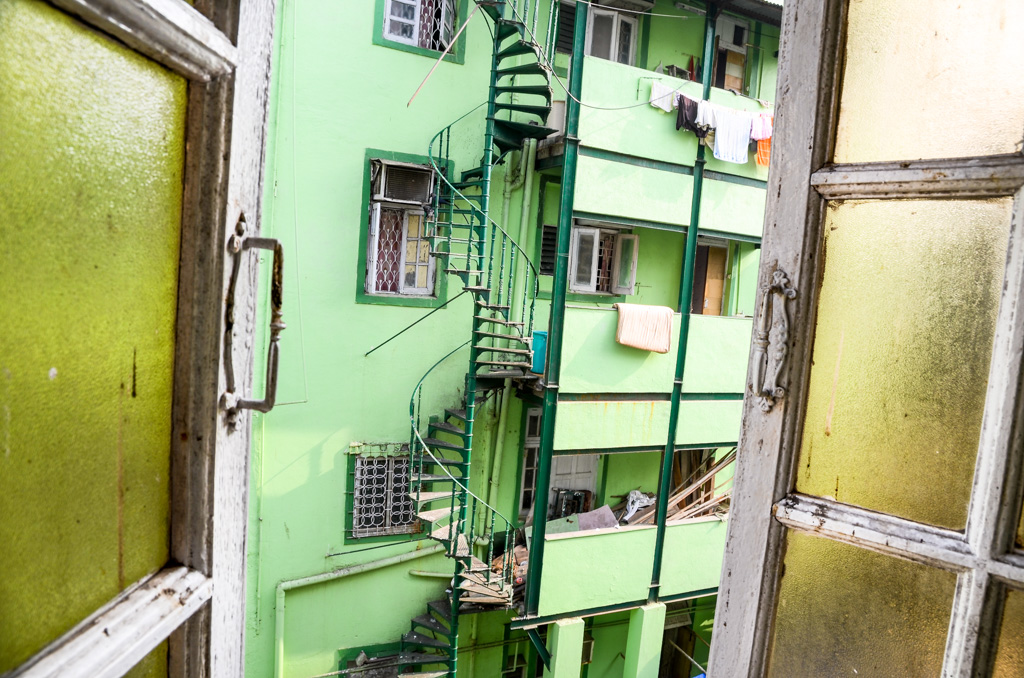
view out the window, first morning in Mumbai.
DAY ONE: Jan 24, 2012
At about 8:00 AM, a group of large, noisy crow-like birds appeared in the tree outside the window of my room in the morning. The pigeons then began to scuttle about on the corrugated metal awning above the window. Add a measure of incessant car horns and a loudly mewing kitten, and you’ve got my first morning in Mumbai.
I said I was traveling solo in India, right? Well, that’s mostly true.
A friend of mine, Kelly, coincidentally began a backpacking trip in India two weeks prior to my arrival and arrived in Mumbai the same day I did – me by air, her by land. She knocked on the door at 10:00 AM. I hadn’t seen her in four years. We split the cost of the room and buddied up to see the city.
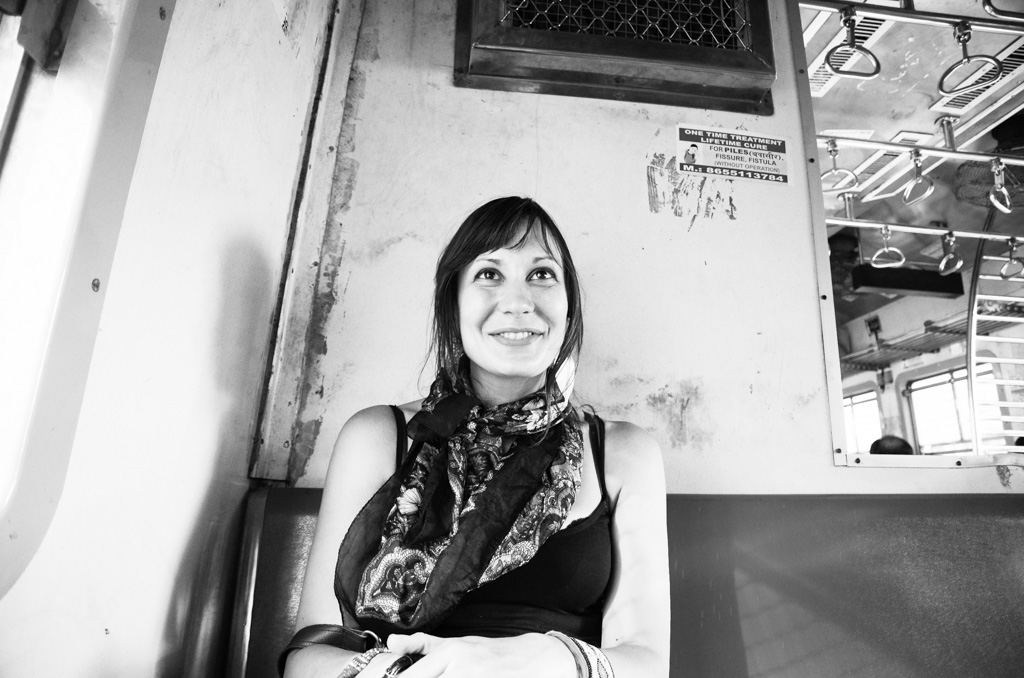
Kelly.
Mumbai is a massive, busy city, and getting around takes time. Be patient and don’t overextend yourself. We scheduled about two touristic stops per day and otherwise just wandered around by foot and by local train to get a feel for the city, taking meals as we pleased.
The Gateway of India, located in Colaba and within walking distance of the guesthouse, was an obvious stop on day one as well as the first place I got scammed in India. An enthusiastic man “blessed” me, made me eat a small handful of sugar candy, tied a knotted yarn bracelet around my arm (which was purposefully difficult to remove), crammed a marigold in my pocket, placed an unwated grease-paint bindi between my eyes, and demanded 200 rupees tribute (which is enough cash for a meal for two!). Frustrated, I think I handed him 50 at the time. These guys must make a killing and are to be avoided. If you need to throw your money away at the Gateway of India, buy a gigantic maraca-shaped balloon from one of the vendors instead – 10-20 rupees should do the trick.
It seemed like everyone at the Gateway of India was either a tourist or someone trying to make a rupee off a tourist. It was an annoying place. We snapped a few pictures and moved on to our next stop, Elephanta Island.
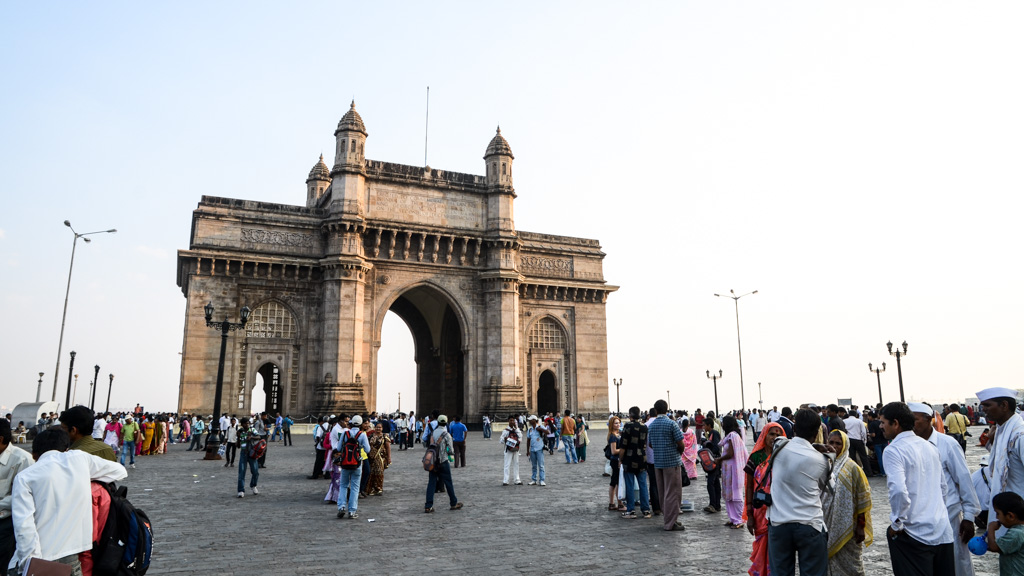
Gateway of India.
Elephanta Island is a smallish island, 10 km to the northeast of the Gateway of India, popular for its series of Buddhist and Hindu caves and stone carvings dated to the 5th and 8th centuries. It takes about an hour to to Elephanta here from Mumbai by way of boat at a cost of 105 rupees per person for economy-class transit, or more for passage on a multi-tiered “luxury” boat.
Admission to the caves, a UNESCO World Heritage site, costs lndian nationals pay ten rupees admission, but foreign tourists pay 250 rupees – twenty-five times the price. Yeah, it’s only US $5 equivalent, but still, it’s a pretty nasty example of mandated and published “tourist price”. No wonder the touts outside the Gateway of India think they should take advantage of travelers – everybody’s doing it, right?
Once you land on Elephanta, you can pay a fee to ride a single-track narrow-gauge tourist railway inland from the dock if you so desire, but it’s only for novelty (and is probably pretty entertaining for kids). We walked, kept our money and beat the train (in fairness, it doesn’t go very far anyway).
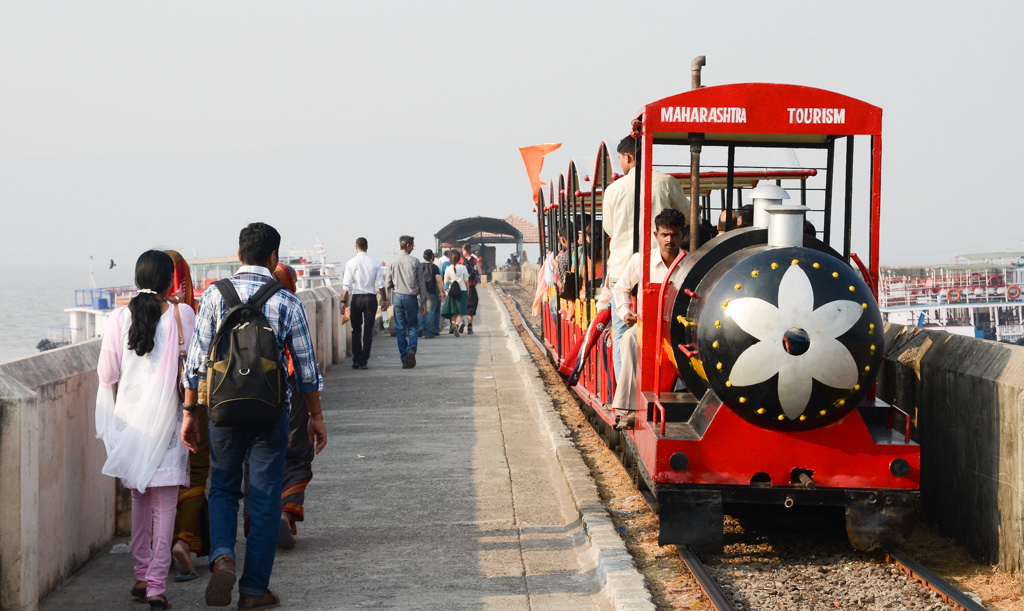
The caves were interesting but mobbed with tourists as expected. The most famous of the Hindu caves features a 3-headed Shiva carving in its center. Aside from the caves themselves, entertainment comes in the form of groupings of conniving (some would say cute) monkeys that’ll try to steal your sunglasses and your soft drink. We spent about an hour at Elephanta Island before heading back to Mumbai by ferry. Total time consumed including time waiting for ferries to leave: around 3.5 hours.
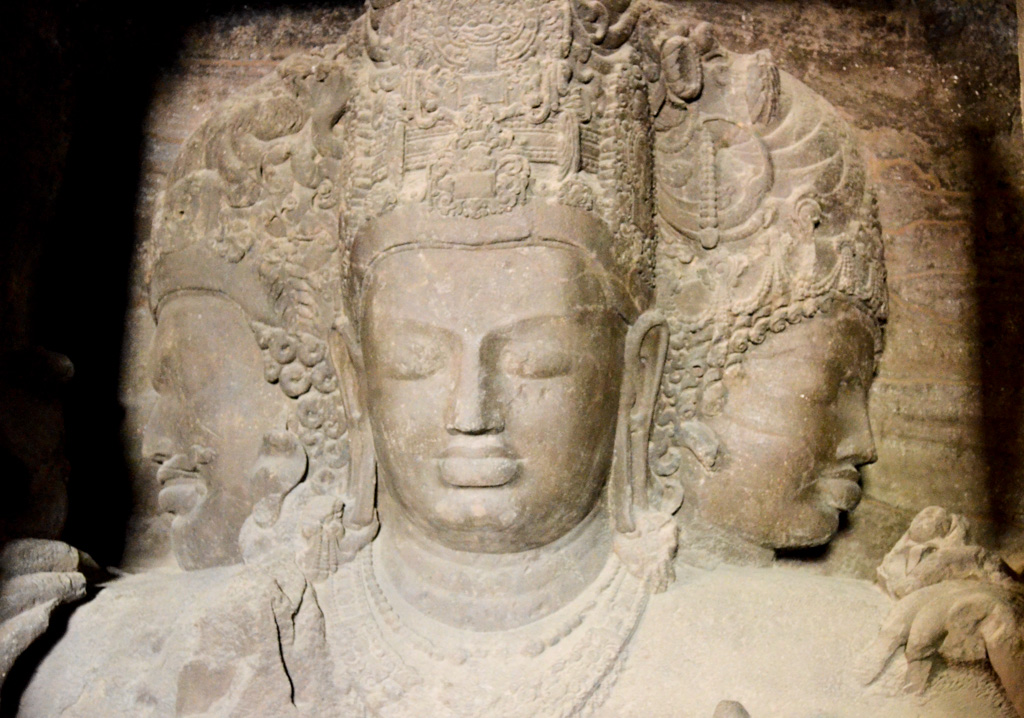
The famous 3-headed Shiva of Elephanta Island.
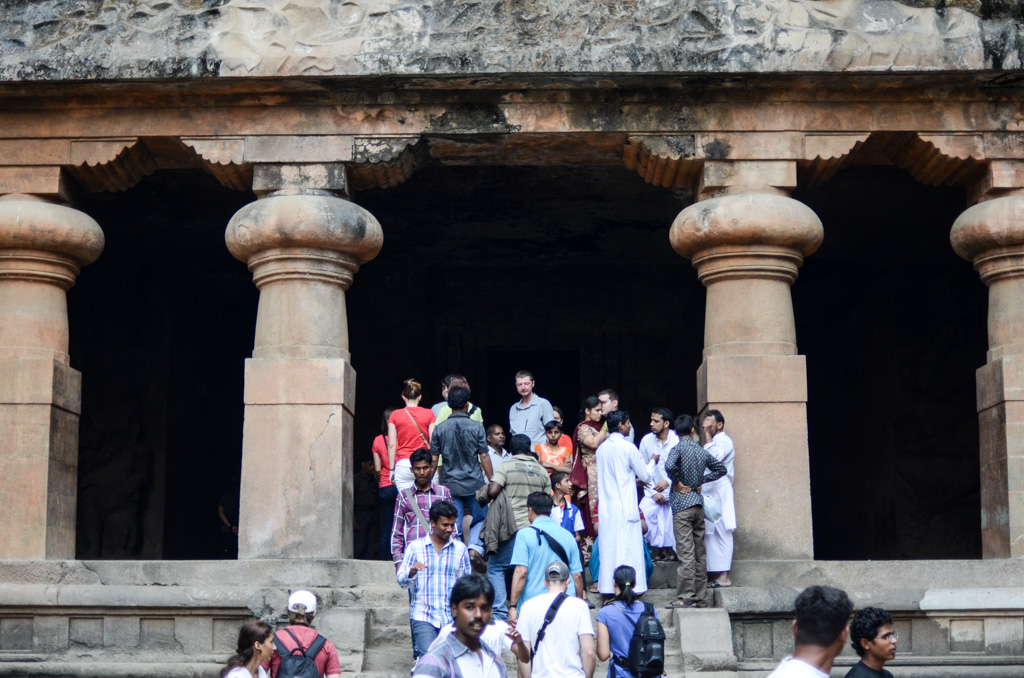
a crowded cave on Elephanta Island.
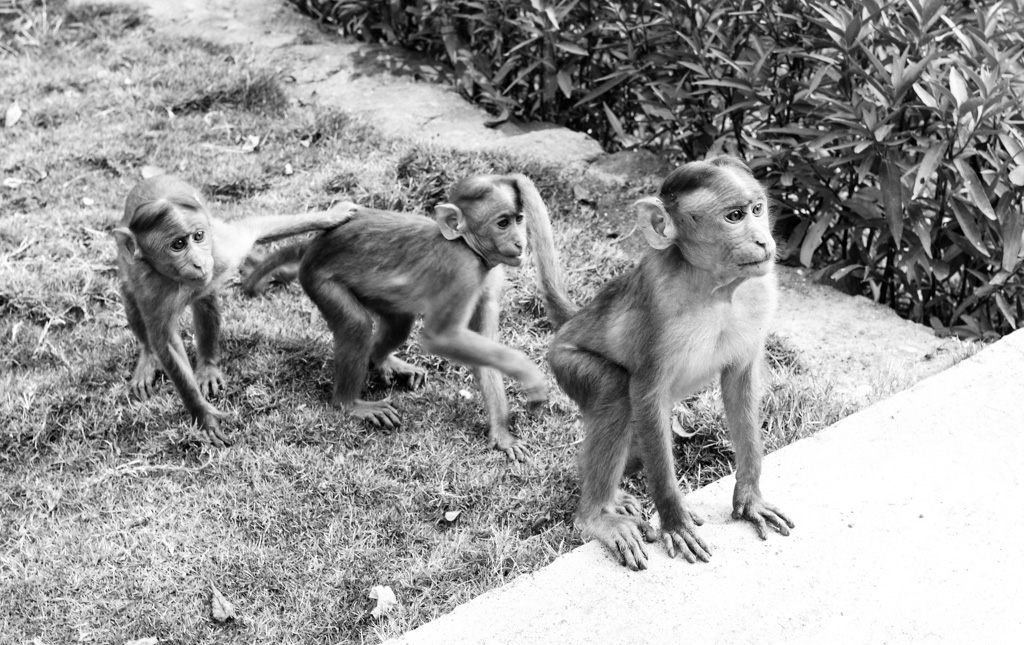
monkeys on Elephanta Island.
DAY TWO: Jan 25, 2012
Our second day in Mumbai, we paid a visit to Haji Ali Dargah, a mosque built in 1431, 500 meters off the western coast of Mumbai and only accessible at low tide by a concrete causeway. This place is rather well-known and sees tens of thousands of tourists weekly.
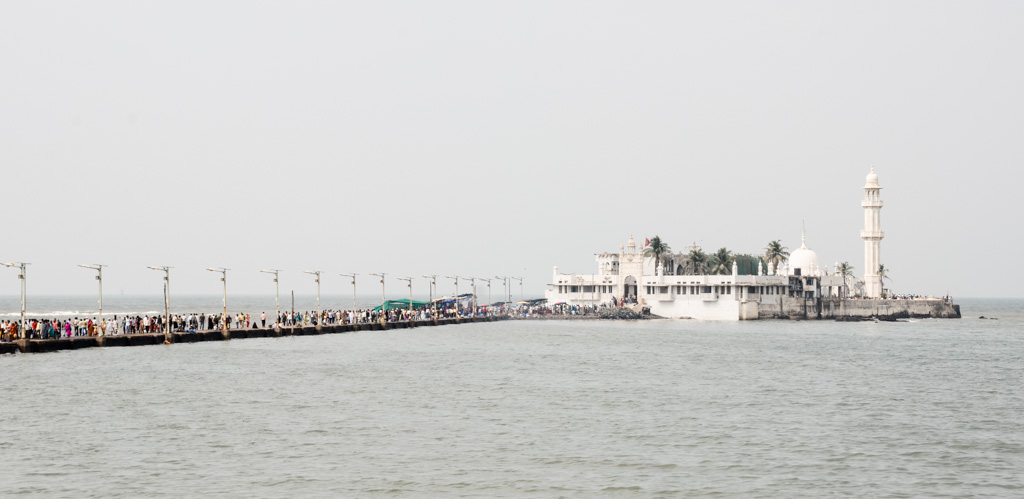
the causeway to Haji Ali Dargah.
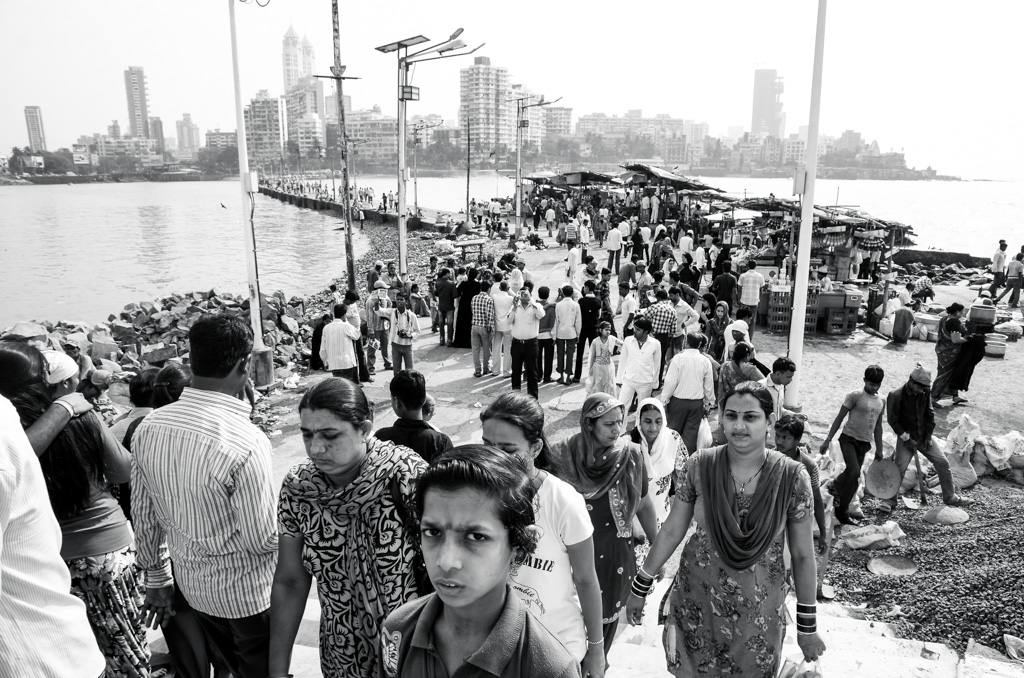
pilgrims en route to Haji Ali Dargah.
Inside the mosque, pilgrims and families were rather interested in taking group pictures with Kelly and I – seemingly moreso than participating in religious or spiritual activities. Kelly was shuffled from one group to the next for “one photo”. We became the mosque’s bonus attraction and couldn’t find a minute of peace to take a look around. Unnerved, I sat down on a planter in the mosque, under a tree. On cue, two seagulls perched in said tree shit on me simultaneously. I was wearing a white shirt.
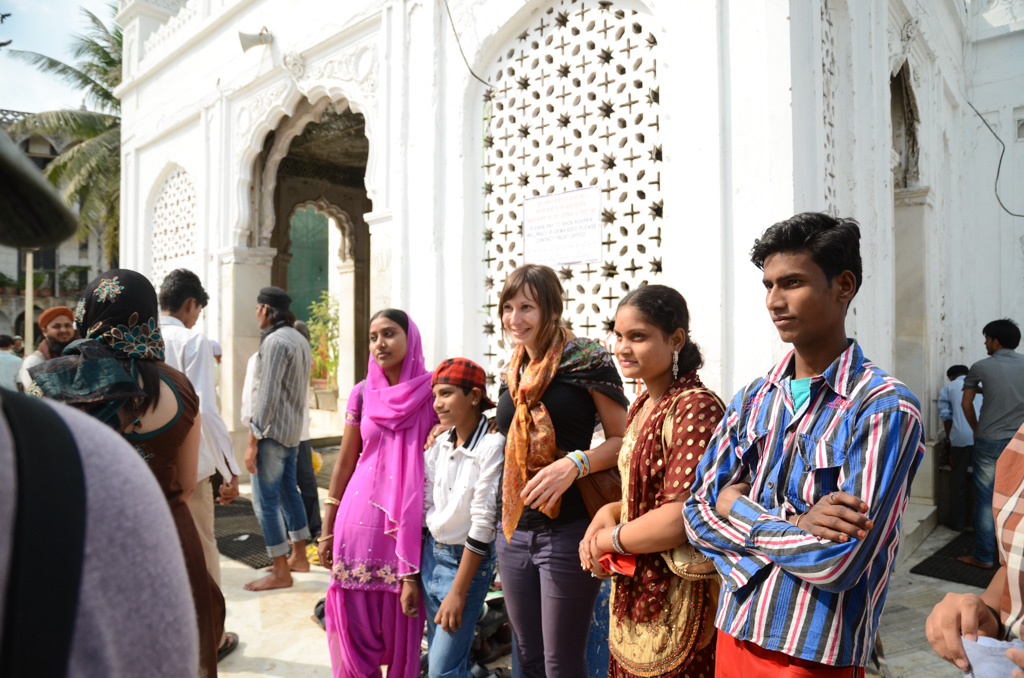
Kelly poses with a family at Haji Ali Dargah.
After playing star at the mosque, we headed back to the commuter train station and to one of Mumbai’s best known beaches – Girgaum Chaupati. It’s kind of a nice place, and kind of a gross place. Families played in the sand in the afternoon sun, there were sweet and salty snacks for purchase from food stalls, and the mood was overall quite good. But the beach is strewn with trash, and you couldn’t pay me enough to get in the water. No way. “Urban Indian beach in city of 21 million” doesn’t mesh well with carefree swimming. But to be fair, when I’m in New York, I don’t swim in the East River either.
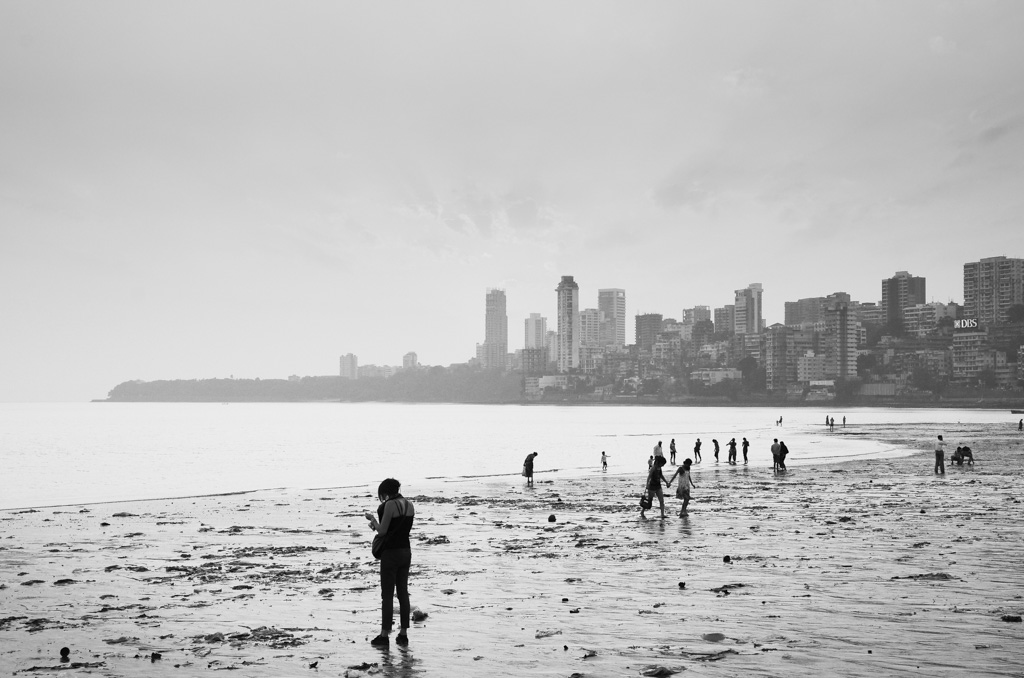
Girgaum Chaupati, Mumbai’s urban beach.
A note: we asked about and casually searched for Mumbai’s supposed legendary “party scene” and found appreciably next to nothing. Bars on the main drag in the Colaba area were filled primarily pubby spots with tourists paying inflated prices for drinks and Indian men that wanted to interact with such tourists, and local bars were generally seedy male-only spots in which they were shocked to see Kelly enter, much less consume alcohol (price check: 650 ml bottles of beer at local bars ran 130-150 rupees). I assume there is a pretty glammed-out club scene somewhere in the city, but we didn’t find it, and we probably weren’t dressed for nor could afford to be a part of it anyway. Ah well.
DAY THREE: Jan 26, 2015
On our third day in Mumbai, we visited Dharavi slum – Asia’s most populous slum, with estimates ranging from 300,000 to one million residents. It took us about 20 minutes to walk to Churchgate station from our guest house, and an hour to travel northbound by rail to the Mahim station, where we disembarked (at a cost of something like 6 rupees one way).
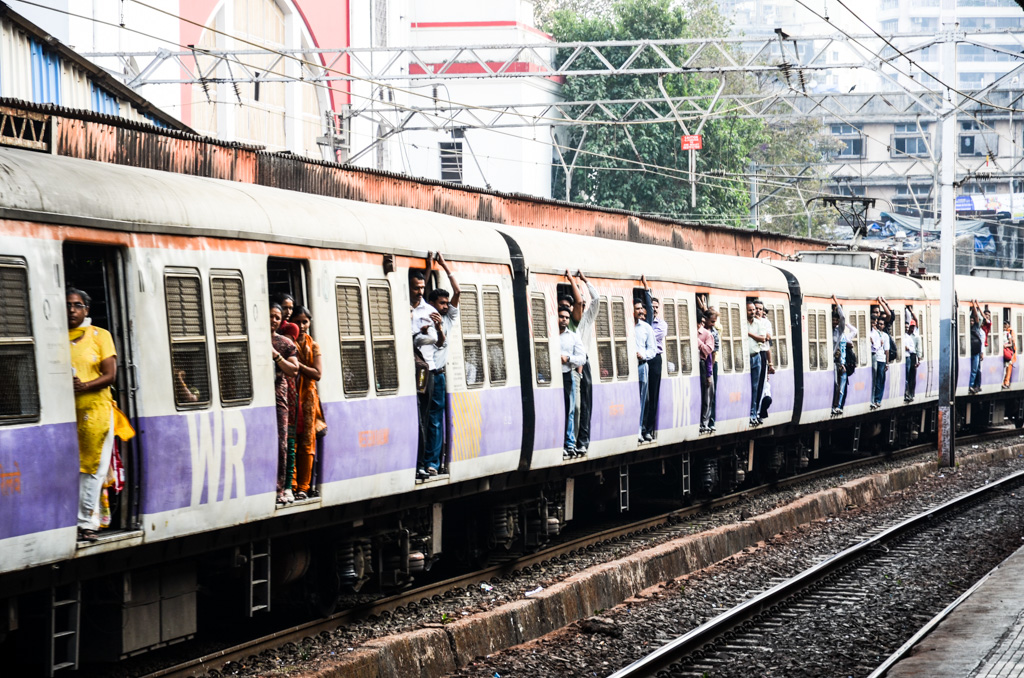
Commuter trains in Mumbai are often so packed with passengers that people hang out the doors. When the trains are at more reasonable capacity, people hang out the doors anyway.
From the Mahim station, we walked immediately east, crossed the bridge over the railway tracks, and arrived in Dharavi, a mishmash of tightly packed improvised dwellings built from available materials like corrugated metal and plastic tarps. We viewed Dharavi primarily from the main road that passes through it (essentially just outside of the slum) and didn’t enter its corridors – it just felt like a potential intrusion on people’s lives and space. Still, it was nice to get a little perspective on such a distinctive and populous part of Mumbai.
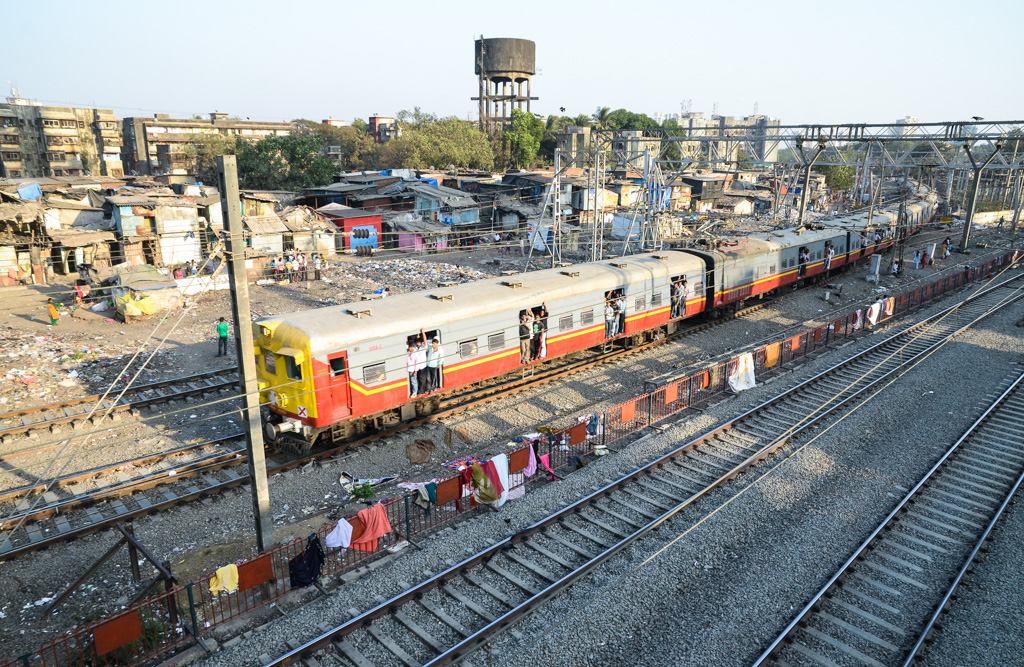
A commuter train passes a portion of Dharavi slum.
We holstered our cameras for the duration of the visit to Dharavi, but as we were exiting and heading back across the footbridge above the train tracks, I couldn’t help myself any longer. I took a few shots of the community just next to the tracks, and found that some of the young men below had taken notice. They smiled our way as I took a picture of them on my camera, and they returned the gesture, taking distant pictures of me on their mobile phones.
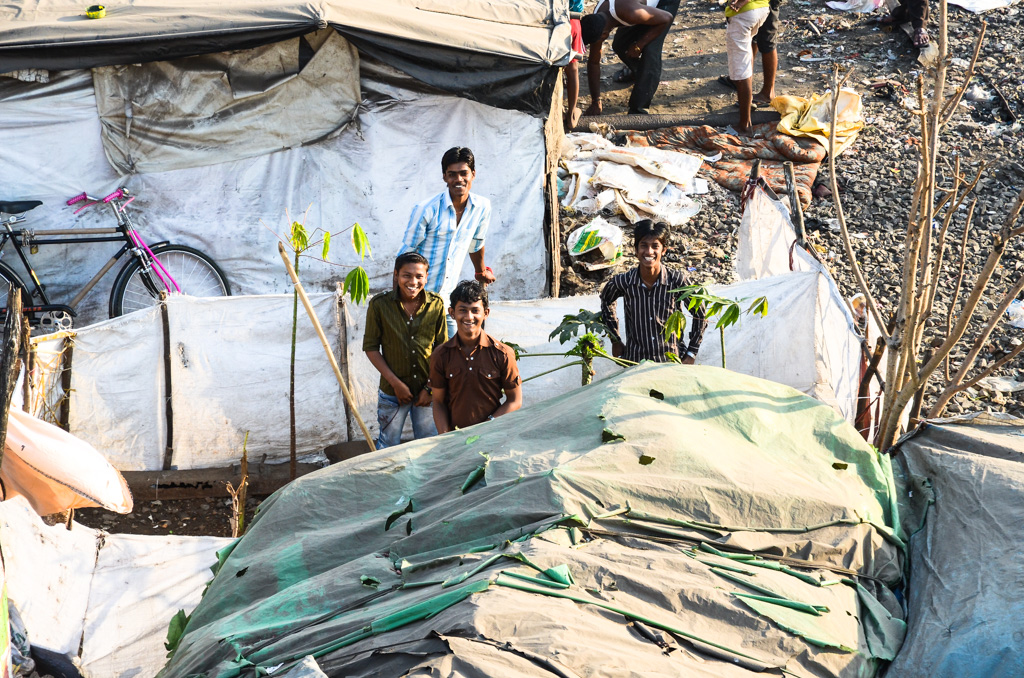
That evening we boarded the 9:30 PM night train from Victoria Station to Jalgaon, the nearest city to the Ajanta Caves complex, our next point of interest.
NEXT STOP: Ajanta Caves (and Jalgaon)

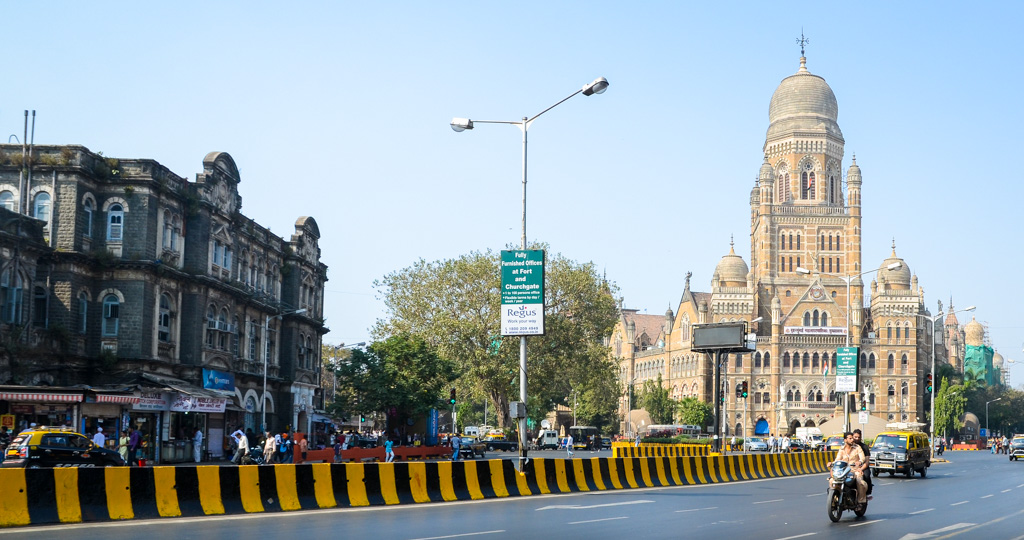






Great writing! Keep it up!
Thank you! It’s been great fun to put this together thus far.